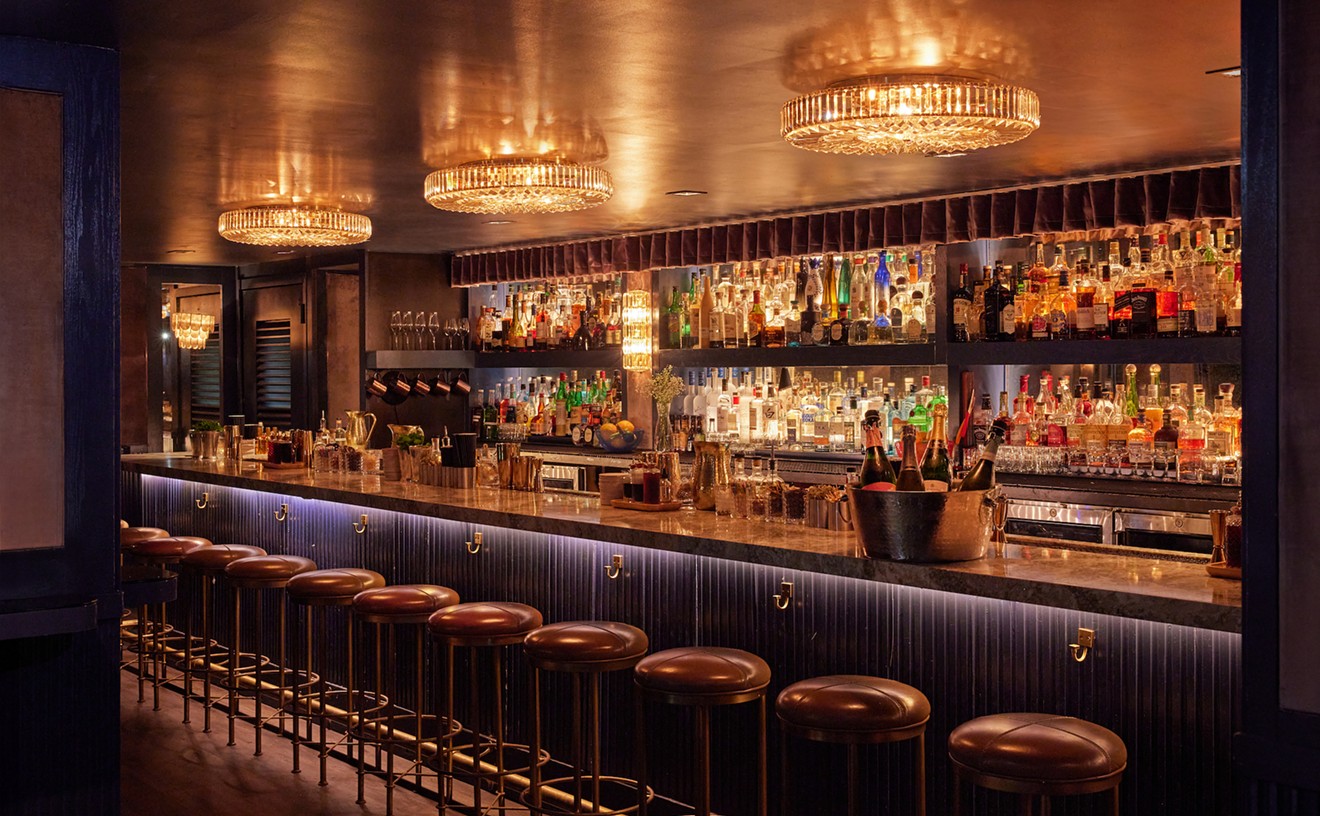She was referring to my review of Azul when it opened at the Mandarin Oriental in 1999. I rapidly ransacked my brain for the sentence to which she might be alluding, but all I could remember writing about was being hustled to the bar for overpriced predinner drinks and expressing the fear that waiters were going to pick me up, turn me upside down, and shake me until the loose change fell from my pockets. I did compliment the cuisine, but in light of the unanimously luminous praise heaped upon Michelle for her star-making turn there, I'm pretty certain my qualified endorsement was the most negative note sounded. So I just stood there, looking uncomfortably puzzled for a second or two, until she recalled the criticism for me: "You wrote that I was playing it safe."
If that was ever true, it certainly is not anymore. Bernstein is, after all, Miami's hottest culinary star, smack-dab in the prime of her career and garnering kudos coast to coast — I mean, not every local chef has flayed Bobby Flay on Iron Chef America. Here's one of many ways Bernstein could be playing it safe right now: She could have multiple backers build her a big, posh dining establishment in South Beach (or New York, Napa, anyplace), where her neon-lit name would do all the work. She would merely have to show up in town now and then, don a designer chef jacket with her name embroidered across the pocket, and make an occasional foray into the dining room. Instead she is sweating it out, literally, over a hot stove in a modest 50-seat restaurant on a not-yet-up-and-coming stretch of Biscayne Boulevard (she was raised just a few miles away in Miami Shores). The intimate, intensely personal nature of the venture is risky as well. Bernstein can no longer take refuge in the Mandarin's five-star setting or be privy to its voluminous purchasing power. Although Steve Perricone is a partner in this venture, Michy's is all Michelle. With her hair down.
She exhibited more courage in allowing me to write about her restaurant from behind the scenes — especially considering Michy's had been operating for barely three weeks, which isn't nearly enough time to get all systems down pat. Granted, I wasn't there simply to observe; I also used my incalculable culinary skills to help out during morning prep. For starters, I peeled a bulb of ginger and squeezed lemons and limes for the daily ceviche that Bernstein was in the process of preparing. "If there are any pits in there, I'm going to blame you," she said, which I took to be a subtle hint I should have juiced the citrus into a separate container rather than directly onto the fish. Oops, too late. Of course, I performed more integral tasks. I picked herbs, diced potatoes into little cubes, sliced potatoes and celery root on a mandoline, and, um ... well the important thing is I didn't get in the way of the rest of the crew very often, which was no small feat in such a cramped space.
The kitchen isn't necessarily small, just crowded. The dishwashing station sits up front. A lengthy bank of reach-in refrigeration units and a pastry/salad station span one side of the room. Equipment such as the stove, grill, fryer, and oven line the other side. Running down the center are work counters where food is plated and garnished, which leaves a narrow pathway on each side of the kitchen and a host of workers to fill in the space. During dinner hours, this includes a pastry chef, salad cook, prep cook, three line cooks, two dishwashers, a Johnson & Wales intern, various waiters bustling in and out to pick up food, Bernstein, and on this particular day, a restaurant critic. Two of those line cooks are likely to be chef Jason Schaan and sous chef Jacob Crabtree, the designated iron men of the kitchen. Both start work at 7:30 a.m. and end their shifts at 11:30 p.m. They do this six days a week.
Altogether it's a young, talented team with a shared goal — perhaps even obsession — to produce gloriously delicious food. Seriously. Bernstein leads the mission and relates to the two J's in an easy, professional manner (they worked with her at Azul). For the first hour or so that I was in the kitchen, Bernstein was all sweetness and smiles, like an Argentine-Jewish version of Reese Witherspoon. Chefs, though, are like heads of state: As charming as they might be, you know they have to possess a tough side to have gotten where they are. Sure enough, when it came time to tackling the pluckier tasks, Bernstein's less Reesey, more cheflike bearing emerged. A spat between a couple of dishwashers was one such incident. After taking the antagonists outside individually for a brief chat, Bernstein gave the sous chef a quick appraisal of the situation, which basically consisted of her not being enthralled by one of the two dishwashers. Judging by her tone, I'd be very surprised if that worker were still washing dishes the next day.
Michy's kitchen operates like the classical old European restaurants of yesteryear, when everything was made from scratch. There are no walk-in freezers, no microwaves, no racks stacked with boxes of pasta, canned goods, premade salad dressings, or shiploads of Sysco products. Whole chickens, ducks, and fish are taken apart and portioned, the bones reserved for stocks. Steaks are cut from the whole sirloin — in a creative manner: A side of New York strip gets turned into stocky, square bricks of meat. Schaan spends hours every morning rolling and cutting various pastas for the day and then meticulously pipes calabaza squash purée (sweetened with crumbled amaretto wafers) into what will be agnolotti — all of this painstaking work for a dish used only as an accompaniment to duck breast with Oaxacan molé. And speaking of painstaking work: Bernstein makes the molé as well. Gnocchi, mayonnaise, French fries: prepared on the premises.
While cleaning a giant white fillet of striped bass, the sous chef noted how exquisite a fish it was. "That is beautiful," Bernstein concurred. "How much was it?" "$11.25 a pound," he replied. The expression on Bernstein's face was similar to that of someone seduced by a potentially perfect pair of shoes in a shop window who then looks closer and sees the $600 price tag.
Let's swim with that striped bass for a while. After it's allotted into neat white rectangles, a prep cook fills each one with a duxelle of black trumpet mushrooms enhanced with garlic, shallots, tarragon, and thyme and then wraps it in brick dough (similar to phyllo). Meanwhile another cook prepares a silky yellow sauce from locally grown corn. Later, when the bass is ordered, a line cook will roast it to a golden brown, ladle a circle of the heated sauce on a plate, and place the fish on top. Bernstein then adds a relish of pickled corn and mushrooms, and checks that everything is in order before the waiter carries it to the dining room. A bowl of rolled, moistened minitowels sits by the station in case the plate rims need wiping.
Wand-shape graters are also positioned here, along with chunks of Pecorino Romano and a black Italian truffle the size of a golf ball. Bernstein used an enthusiastic hand while shaving both, which isn't surprising; there is something generous about all of the food here. Even the lunchtime hamburgers are plump, hand-formed, and graced with tomato wedges so thick, juicy, and fire-engine red they look like models for an ad campaign by the Council for Higher Tomato Sales.
Desserts such as baked Alaska and strawberry shortcake are crafted in-house too, the former coming under discussion when a couple of cooks questioned whether the dulce de leche ice-cream filling made it too sweet (it is also layered with pistachio ladyfingers and drizzled with passion fruit sauce). Bernstein didn't think so, and apparently the debate got back to either the pastry chef or front of house, who a short time later sent word that the baked Alaska was getting rave reviews from the customers and is one of the top sellers. I, meanwhile, stole away to the back corner of the kitchen and set about gobbling down my lunch, slices of foie gras torchon (the liver marinated in brandy/madeira, wrapped into a cylindrical shape, and poached) with delicate brioche toasts and blood orange marmalade. Yummy.
The dinner menu isn't categorized into appetizers and main courses but is rather a compilation of 30 to 35 dishes offered as half or full orders. Some of the listings are more starterlike than others, such as ceviche, carpaccios, salads, and raw bar selections, the last served from the dining room. Half orders are priced around $6 to $12, and most full entrée-size meals run $14 to $22, which is inexpensive enough to encourage the sampling of numerous items. This leads to creative ordering from customers, who might start off with a series of half orders followed by full orders, or divide their meal into three courses of halves and fulls, or just order a slew of halves; the potential variations seem infinite.
This system also lends itself to a somewhat complex call-off of dishes by the expediter (Bernstein), which during dinner rush works like this: A little ticker-tape machine in the kitchen spits tickets out like news bulletins during a crisis, and the chef/expediter must instantaneously read, analyze, total, and assign the assorted menu items in her head and then holler them out. Each line cook repeats his respective orders back to confirm he has it right, so the kitchen ends up sounding like a fast-talking country auctioneer in a roomful of enthusiastic bidders:
"Order and fire [begin cooking] one half quail, half a hankie, half sweetbread" (which would be Southern fried quail with black-eyed peas, honey, and peaches; handkerchief pasta with wild mushrooms in cognac and tarragon; and sour orange-glazed sweetbreads with bacon).
"Ordering one full cod, one full lamb, one half torchon. Fire one half salmon. Fire one full confit, two full ducks. Pick up one full scallops, two full rabbits...." and on and on and on, with the cooks' echoes, as the 50 seats fill, empty, fill, empty, and sometimes fill again.
I did not need to concern myself with any of this. My main focus was to revel in whatever dishes Bernstein or one of the line cooks would pass me from time to time. Turks and Caicos conch fillets "escargot style" was the first hand-off, tender fillets tucked into mini conch shells and bathed in garlic, parsley, and butter. Airy potato gnocchi in a Bolognese sauce flecked with duck sausage came next, followed by polenta capped with crisp bacon bits, a softly poached egg, and grated Pecorino and truffles. The three dishes exemplify Michy's cuisine: simple, comforting, and rustic, with bold, quality flavors. A little bowl of the polenta goes for $7, and a larger serving for $12, which left me convinced I couldn't find a better plate of food for the money — that is, until I tried the salad of watercress tossed with fresh tarragon leaves, halved green grapes, goat cheese, caramelized shallots, and a light balsamic dressing ($7/$11).
Tickets were still clicking into the kitchen, pans still clacking on the stove, voices still volleying orders back and forth above the din as I walked out the back door at 9:00 p.m. The thought has since occurred to me that maybe Bernstein was more crafty than courageous in letting me witness Michy's kitchen. After all, she must have known her ingredients are so unquestionably honest, the process of preparing them so pure, the food so rife with integrity that I wouldn't be able to criticize any of it. I think it's safe to say she was correct.











